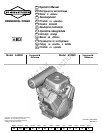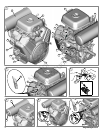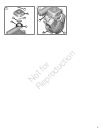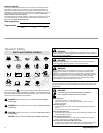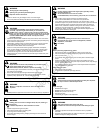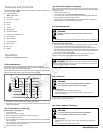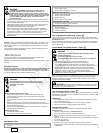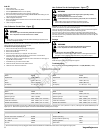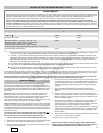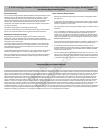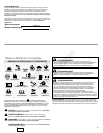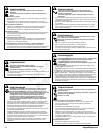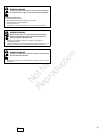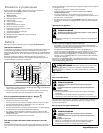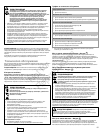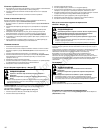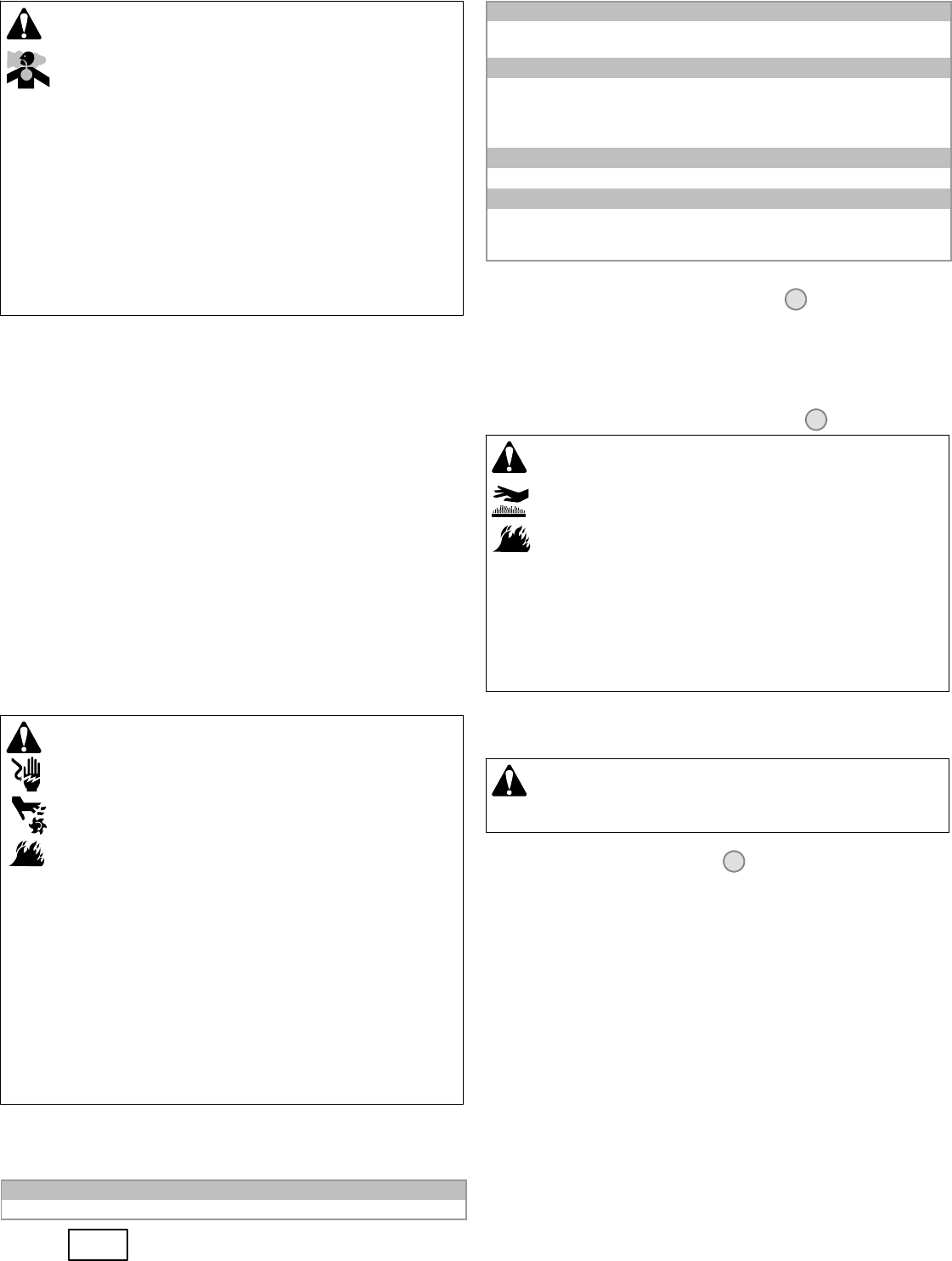
7
en
POISONOUS GAS HAZARD. Engine exhaust contains carbon
monoxide, a poisonous gas that could kill you in minutes. You
CANNOT see it, smell it, or taste it. Even if you do not smell exhaust
fumes, you could still be exposed to carbon monoxide gas. If you start
to feel sick, dizzy, or weak while using this product, shut it off and get
to fresh air RIGHT AWAY. See a doctor. You may have carbon
monoxide poisoning.
WARNING
Operate this product ONLY outside far away from windows, doors and vents to
reduce the risk of carbon monoxide gas from accumulating and potentially being
drawn towards occupied spaces.
Install battery--operated carbon monoxide alarms or plug--in carbon monoxide
alarms with battery back-up according to the manufacturer’s instructions.
Smoke alarms cannot detect carbon monoxide gas.
DO NOT run this product inside homes, garages, basements, crawlspaces,
sheds, or other partially-enclosed s paces even if using fans or opening doors
and windows for ventilation. Carbon monoxide can quickly build up in these
spaces and can linger for hours, even after this product has shut off.
ALWAYS place this product downwind and point the engine exhaust away from
occupied spaces.
NOTICE: This engine was shipped from Briggs & Stratton without oil. Before you start
the engine, make sure you add oil according to the instructions in this manual. If you
start the engine without oil, it will be damaged beyond repair and will not be covered
under warranty.
For information on starting and stopping the engine, read the operating instructions
supplied by the equipment manufacturer.
Maintenance
We recommend that you see any Briggs & Stratton Authorized Dealer for all
maintenance and service of the engine and engine parts.
NOTICE: All the components used to build this engine must remain in place for proper
operation.
Emissions Control
Maintenance, replacement, or repair of the emissions control devices and systems
may be performed by any non-road engine repair establishment or individual.
However, to obtain “no charge” emissions control service, the work must be performed
by a factory authorized dealer. See the Emissions Warranty.
Unintentional sparking can result in fire or electric shock.
Unintentional start-up can result in entanglement, traumatic
amputation, or laceration.
Fire hazard
WARNING
Before performing adjustments or repairs:
Disconnect the spark plug wire and keep it away from the spark plug.
Disconnect battery at negative terminal (only engines with electric start.)
Use only c orrect tools.
Do not tamper with governor spring, links or other parts to increase engine
speed.
Replacement parts must be of the same design and installed in the same
position as the original parts. Other parts may not perform as well, may damage
the unit, and may result in injury.
Do not strike the flywheel with a hammer or hard object because the flywheel
may later shatter during operation.
When testing for spark:
Use approved spark plug tester.
Do not check for spark with spark plug removed.
Maintenance Chart
First 5 Hours
Change oil
Every8HoursorDaily
Check engine oil level
Clean area around muffler and controls
Every 100 Hours or Annually
Clean or change air filter *
Y
Change engine oil and filter
Replace spark plug
Check muffler and spark arrester
Every 250 Hours or Annually
Check valve clearance. Adjust if necessary.
Every 400 Hours or Annually
Change air f ilter
Y
Clean air cooling system *
Clean oil c ooler fins *
* In dusty conditions or when airborne debris is present, clean more often.
How To Replace The Spark Plug - Figure
3
Check the gap (A, Figure 3) with a wire gauge (B). If necessary, reset the gap. Install
and tighten the spark plug to the recommended torque. For gap setting or torque, see the
Specifications section.
Note: In some areas, local law requires using a resistor spark plug to suppress ignition
signals. If this engine was originally equipped with a resistor spark plug, use the same
type for replacement.
Inspect Muffler And Spark Arrester - Figure
4
Running engines produce heat. Engine parts, especially muffler,
become extremely hot.
Severe thermal burns can occur on contact.
Combustible debris, such as leaves, grass, brush, etc. can catch fire.
WARNING
Allow muffler, engine cylinder and fins to cool before touching.
Remove accumulated debris from muffler area and cylinder area.
It is a v iolation of California Public Resource Code, Section 4442, to use or
operate the engine on any forest-covered, brush-covered, or grass-covered land
unless the exhaust system is equipped with a spark arrester, as defined in
Section 4442, maintained in effective working order. Other states or federal
jurisdictions may have similar laws. Contact the original equipment
manufacturer, retailer, or dealer to obtain a spark arrester designed for the
exhaust system installed on this engine.
Remove accumulated debris from muffler area and cylinder area. Inspect the muffler (A,
Figure 4) for cracks, corrosion, or other damage. Remove the spark arrester (B), if
equipped, and inspect for damage or carbon blockage. If damage is found, install
replacement parts before operating.
WARNING: Replacement parts must be of the same design and installed
in the same position as the original parts. Other parts may not perform as well, may
damage the unit, and may result in injury.
How To Change The Oil - Figure
5
Used oil is a hazardous waste product and must be disposed of properly. Do not discard
with household waste. Check with your local authorities, service center, or dealer for safe
disposal/ recycling facilities.
Remove Oil
1. With engine off but still warm, disconnect the spark plug wire (A) and keep it away
from the spark plug (Figure 5).
2. Remove the oil drain plug (B). Drain the oil into an approved container.
3. After the oil has drained, install and tighten the oil drain plug.
Change The Oil Filter
All models are equipped with an oil filter. For replacement intervals, see the
Maintenance chart.
1. Drain the oil from the engine. See Remove Oil section.
2. Remove the oil filter (C, Figure 5) and dispose of properly.
3. Before you install the new oil filter, lightly lubricate the oil filter gasket with fresh,
clean oil.
4. Install the oil filter by hand until the gasket contacts the oil filter adapter, then tighten
theoilfilter1/2to3/4turns.
5. Add oil. See Add Oil section.
6. Start and run the engine. As the engine warms up, check for oil leaks.
7. Stop the engine and check the oil level. It should be at the top of the full indicator (F)
on the dipstick.
Not for
Reproduction



